Sharks in the Gulf of Mexico & Texas: Full List
The Gulf of Mexico is home to many different species of sharks, including:
Bull Sharks
Mako Sharks
Tiger Sharks
Hammerhead Sharks
White Sharks
Atlantic Sharpnose Shark
Blacktip Shark
Bonnethead Shark
Spinner Shark
Bull Shark
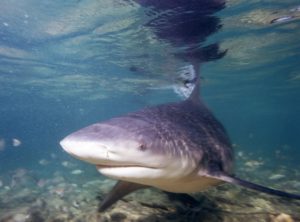
Temperament: Aggressive
Color: Brown to greyish-brown on top with a cream white underbelly
Size: 7 to 11.5 feet
Weight: Between 500 to 800lbs
The bull shark (Carcharhinus leucas), also known as the ” Zambezi shark” in Africa, is a requiem shark that is considerably widespread in warm, shallow waters along coasts in the Western Atlantic Ocean, including the Gulf of Mexico and the Caribbean Sea, as well in the Eastern Pacific Ocean along the coasts of Central and South America.
The bull shark is known for its aggressive nature and is considered one of the most dangerous sharks in the world. Bull sharks often live in close proximity to humans and can be found in both freshwater and saltwater environments. They are relatively common in brackish and freshwater rivers, lakes, and estuaries.
The bull shark is a large and stocky shark with a short, blunt snout. It can grow to be up to 12 feet long and weigh up to 1,000 pounds. The upper and lower lobes of the tail are nearly equal in size. The first dorsal fin is large and triangular, with a pointed tip. The pectoral fins are small and rounded.
The coloration of the Texas bull shark is a brown to grayish-brown color on top and white on the underside.
The bull shark is a dangerous predator that is known to attack humans. Although there are only a few hundred reported cases of bull shark attacks on humans, these sharks are responsible for a significant number of fatal attacks. The majority of bull shark attacks occur in shallow, murky waters where visibility is poor and the shark is more likely to mistake a human for its natural prey.
A few fishermen have caught bull sharks over the last year, see more here:
Fisherman reels in 7.5-foot bull shark along Texas coast
Liberty woman reels in shark while fishing in the Trinity River
Shortfin Mako Shark

Temperament: Fast & Aggressive
Color: Blue-gray hue or cobalt blue on top with a snowy white underbelly
Size: Up to 12 feet
Weight: Up to 1,200lbs
The shortfin mako shark is a large pelagic shark that is found in temperate and tropical waters worldwide. It is one of the fastest and most agile sharks in the sea and is known for its spectacular leaps out of the water. The shortfin mako is an apex predator and is known to attack and eat other sharks, including great white sharks. Mako sharks also have the largest brain-to-body ratios, meaning they are extremely intelligent with critical reasoning and social skills. In fact, they are so intelligent that they don’t even rely on using their ampullae of Lorenzini to find prey or navigate throughout the oceans.
It is a highly migratory species and is often found far from shore. The shortfin mako is considered to be endangered due to overfishing and is protected in many countries.
Tiger Shark
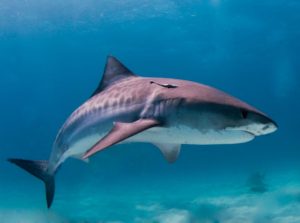
Temperament: Aggressive Hunters
Color: Dark gray on top with a pale white underbelly
Size: Up to 14 feet
Weight: Between 800 to 1,400lbs
Tiger sharks are one of the most feared predators in the ocean. They get their name from the distinctive tiger-like stripes on their body. The largest tiger shark ever measured was 18 feet in length with an estimated weight over 1,500 pounds.
They are found in tropical and temperate waters around the world and are very common in the Gulf of Mexico and off the coast of Texas. Tiger sharks are known for their voracious appetite and will eat just about anything they can find. Their diet consists of fish, seals, sea turtles, birds, squid, and even other sharks. Tiger sharks are also known to be scavengers and will often eat the carcasses of dead animals they find floating in the water.
They have been responsible for the second most attacks on humans after white sharks. Most attacks by tiger sharks are not fatal, but they can cause serious injuries. If you are swimming in waters where tiger sharks have been recently reported, it is important to be aware of the dangers they pose. Be sure to swim in groups and avoid swimming alone. Avoid swimming at night or in murky waters where visibility is low. And, if you see a tiger shark, try to stay calm and avoid making any sudden movements.
Hammerhead Shark
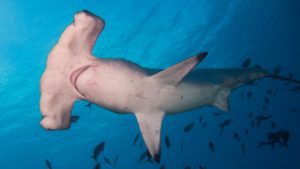
Temperament: Aggressive Hunter but Mild Temperament Otherwise
Color: Brown-gray or olive hue on top with an off-white underbelly
Size: Up to 20 feet
Weight: Up to 1,000lbs
The hammerhead shark is a member of the family Sphyrnidae, and is characterized by a flattened hammer- or crescent-shaped head, called a cephalofoil. Most hammerhead species are placed in the genus Sphyrna, while the winghead shark is placed in its own genus, Eusphyra.
Hammerheads are found in the Gulf of Mexico along the Texas coastlines. Unlike most sharks, hammerheads swim with their heads held up at an angle, instead of flat against the body. The hammer-like shape of the cephalofoil allows the shark to see in many directions at once, giving it 360-degree vision. The cephalofoil also houses the shark’s ampullae of Lorenzini, which are sensory organs that can detect the electromagnetic fields generated by living things. This allows the shark to sense prey that may be hidden in the sand or other substrates.
The hammerhead shark is a relatively large shark, with some species reaching lengths of over 6 m (20 ft). The great hammerhead (Sphyrna mokarran) is the largest, with a maximum recorded length of 20 ft and a maximum recorded weight of 2,800 lbs.
Despite their reputation, hammerhead sharks are an important part of the ocean ecosystem. The diet of hammerhead sharks varies by species but generally includes fish, squid, octopuses, and crustaceans. The sharks use their cephalofoils to herd prey into small groups before attacking.
Hammerhead sharks are apex predators, meaning that they are at the top of the food chain and have no natural predators. However, they are sometimes targeted by humans for their fins, which are used in shark fin soup, and their meat, which is considered to be of good quality.
These sharks are known to be aggressive and have attacked humans a hand full of times. However, attacks on humans are rare, and most hammerhead shark encounters with humans are harmless.
White Shark
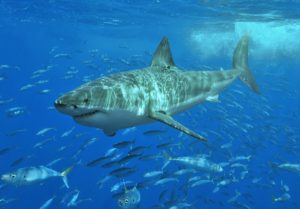
Temperament: Curious, Territorial & Aggressive
Color: Dark grey on top with their infamous bright white underbelly
Size: From 11 to 21 feet
Weight: Between 1,200 to 1,700lbs
White sharks are rarely reported off the coast of Texas, but it is important to know that there are some out there. White sharks are one of the most feared predators in the ocean. Growing up to 20 feet in length, these massive sharks are armed with razor-sharp teeth and a powerful tail that can propel them through the water at speeds of up to 35 miles per hour.
White sharks are known to attack humans, although fatalities are rare. When they do attack, it is often with devastating force, leaving their victims with serious injuries or even death. They are the number one shark involved in attacks on humans.
Despite their reputation as man-eaters, white sharks are actually quite shy and elusive creatures. They are mostly found in deep offshore waters and tend to avoid contact with humans. However, when they are encountered by humans, they are often curious and may approach out of curiosity. This can sometimes lead to dangerous situations, as the sharks may mistake humans for their natural prey.
While white sharks are certainly one of the most feared animals in the ocean, they are also one of the most fascinating. These massive predators have been around for millions of years, and play an important role in the ocean ecosystem. White sharks are apex predators and this gives them a vital role in maintaining the balance of the marine ecosystem. Despite their reputation, white sharks are actually quite elusive and shy creatures. While encounters with humans can sometimes be dangerous, these massive predators play an important role in the ocean ecosystem.
Atlantic sharpnose shark

Temperament: Mild to Moderate, Not usually aggressive
Color: Olive-gray to brownish hue on top with a white underbelly
Size: Up to 3.5 feet
Weight: Between 6 to 9lbs
The Atlantic sharpnose shark (Rhizoprionodon terraenovae) is a small requiem shark, in the family Carcharhinidae, that inhabits the western Atlantic Ocean from Massachusetts to southern Brazil, including the Texas coastline, Gulf of Mexico and the Caribbean Sea. It typically inhabits coastal waters over continental and insular shelves, at depths of 3.3–328.1 ft, though it has been recorded as deep as 899 ft.
This species is characterized by a long, slender snout, large triangular first dorsal fin, and a light gray or brown back with a white or yellowish belly. The largest Atlantic sharpnose shark ever recorded was over four feet and a weight of 16lbs.
The diet of the Atlantic sharpnose shark consists mainly of small bony fishes, squid, and crustaceans. This species is viviparous, with the females giving birth to litters of four to seven young in summer. The Atlantic sharpnose shark is of minor commercial importance, though its meat is marketed as fresh, frozen, or dried-salted.
This species is sometimes considered a nuisance by recreational fishermen, as it often takes baited hooks meant for larger sharks.
Blacktip shark
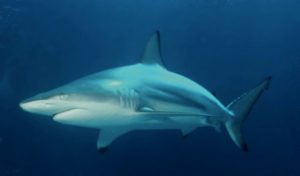
Temperament: Timid and not usually aggressive
Color: Light gray to brownish-gray top with cream white underbelly
Size: From 5 to 7 feet
Weight: Between 50 to 150lbs
The Blacktip shark (Carcharhinus limbatus) is a species of requiem shark, in the family Carcharhinidae. It is relatively small and slender for a requiem shark, typically growing to a length of 5 feet and a weight of 51 to 99lbs.
The Blacktip shark is characterized by a long, narrow body with a pointed snout, small eyes, and blacktips on its first dorsal fin and pectoral fins. The Blacktip shark is found in tropical and subtropical waters worldwide, often near coral reefs and other coastal habitats. It is a viviparous species, with females giving birth to live young.
A typical Blacktip shark diet consists of small fish, squid, and crustaceans. Blacktip sharks are opportunistic feeders and will also eat larger prey items if the opportunity presents itself. Their diet varies depending on what is available in their environment, but they typically prefer shallower waters where there is an abundance of small fish.
Bonnethead shark (Shovelhead)
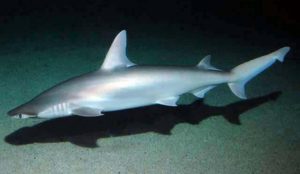
Temperament: Timid & mostly harmless
Color: Greyish-brown top with a pale white underbelly
Size: Up to 4 feet
Weight: Between 13 to 24lbs
The bonnethead shark is a small member of the hammerhead family, Sphyrnidae. The bonnethead is easily distinguished from other hammerhead sharks by its small size and uniquely shaped head, which resembles a shovel or spade. This species is relatively harmless to humans and is considered a minor nuisance by fishermen.
The bonnethead shark is a small, stocky shark with a flattened head and a blunt, shovel-shaped snout. The eyes are small and set well back on the head, and the gill slits are located behind the eyes. The first dorsal fin is small and rounded, while the second dorsal fin is larger and falcate (sickle-shaped). The pectoral fins are broad and rounded, and the pelvic fins are small and triangular. The caudal peduncle (the narrow stalk connecting the tail fin to the body) is thick and muscular, and the tail fin is deeply forked. The dermal denticles (tiny tooth-like structures on the skin) are small and overlapping, giving the skin a smooth feel.
The bonnethead shark is olive-green to gray above and white below, with a white band on the flanks. Young sharks may have dark spots on their fins. This species grows to a maximum length of about 48 inches, with males being slightly larger than females. They reach maturity at about four years of age.
The bonnethead shark is found in shallow coastal waters, bays, and estuaries in the western Atlantic Ocean from North Carolina to Brazil, and in the eastern Pacific Ocean from Baja California to Peru. This species is relatively common in the Gulf of Mexico from Florida to Texas, where it is often found in seagrass beds.
The bonnethead shark is a bottom-dwelling shark that feeds on crustaceans, mollusks, and small fishes. This species is known to eat crabs, shrimp, squid, and octopus.
Spinner shark
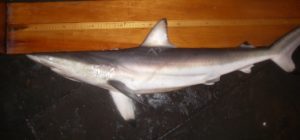
Temperament: Mild to Moderate, Not usually aggressive
Color: Gray, copper tinted top with a faint white underbelly
Size: From 6 to 9 feet
Weight: Between 100 to 200lbs
The spinner shark is a species of requiem shark, in the family Carcharhinidae. The spinner shark is found in tropical and subtropical waters worldwide, often near the surface. The name “spinner shark” comes from its habit of swimming in a vertical or tight spiral when hunting. This feeding method allows them to consume large quantities of food in a single meal.
It is a relatively small species of shark, reaching a maximum length of just over 9.8 feet.
The spinner shark has a slender, fusiform body with a long, pointed snout. The first dorsal fin is large and triangular, with a small notch in the trailing edge. The second dorsal fin is much smaller than the first and originates over or behind the anal fin. The pectoral fins are long and narrow, and the pelvic fins are small and falcate. The caudal peduncle is slender, and the tail is long and crescent-shaped. The dermal denticles on the body are small and overlapping, with five to seven-tooth rows in each row.
The spinner shark has a grey color outer body and white belly, with a distinct line of demarcation between the two colors. There are often dark spots on the body, and the fins may have dark tips. Juveniles often have a band of dark pigment along the flanks.
Texas Shark Tracker
If you’d like a live look at all the sharks that have been tagged in the Gulf of Mexico and off the coast of Texas, use the Ocearch Shark Tacker.

